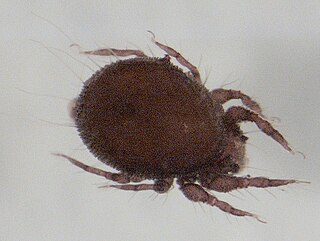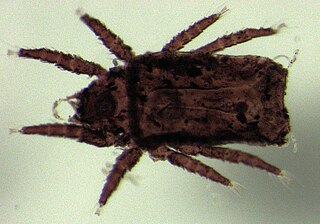Micreremidae is a family of oribatids in the order Oribatida. There are at least 4 genera and about 14 described species in Micreremidae.
Megeremaeidae is a family of oribatids in the order Oribatida. There is at least one genus, Megeremaeus, and about eight described species in Megeremaeidae.
Gymnodamaeidae is a family of oribatids in the order Oribatida. There are about 8 genera and at least 60 described species in Gymnodamaeidae.

Hermanniellidae is a family of oribatids in the order Oribatida. There are about 9 genera and at least 50 described species in Hermanniellidae.

Hydrozetidae is a family of oribatids in the order Oribatida. There is at least one genus, Hydrozetes, and at least 20 described species in Hydrozetidae.
Scutoverticidae is a family of oribatids in the order Oribatida. There are about 8 genera and at least 50 described species in Scutoverticidae.
Neoliodidae is a family of oribatids in the order Oribatida. There are at least 4 genera and 50 described species in Neoliodidae.

Camisiidae is a family of oribatids in the order Oribatida. There are at least 3 genera and 70 described species in Camisiidae.

Hermanniidae is a family of oribatids in the order Oribatida. There are at least 3 genera and 80 described species in Hermanniidae.
Brachychthoniidae is a family of oribatids in the order Oribatida. There are about 11 genera and at least 150 described species in Brachychthoniidae.
Hypochthoniidae is a family of oribatids in the order Oribatida. There are at least 4 genera and 20 described species in Hypochthoniidae.
Nothridae is a family of oribatids in the order Oribatida. There are at least 3 genera and 70 described species in Nothridae.
Cosmochthoniidae is a family of cosmochthoniids in the order Oribatida. There are about 6 genera and at least 40 described species in Cosmochthoniidae.
Achipteriidae is a family of mites and ticks in the order Sarcoptiformes. There are about 9 genera and at least 80 described species in Achipteriidae.
Mochlozetidae is a family of mites and ticks in the order Sarcoptiformes. There are about 12 genera and at least 50 described species in Mochlozetidae.
Oribatulidae is a family of mites and ticks in the order Sarcoptiformes. There are about 19 genera and at least 200 described species in Oribatulidae.
Haplozetidae is a family of mites and ticks in the order Sarcoptiformes. There are at least 20 genera and 210 described species in Haplozetidae.
Phenopelopidae is a family of oribatid mites in the order Sarcoptiformes. As of 2018, there were 4 genera and 106 species known in this family.

Ereynetidae is a family of prostig mites in the order Trombidiformes. There are at least two genera and two described species in Ereynetidae.
Eupodidae is a family in the order Trombidiformes. There are at least two genera and three described species in Eupodidae.





